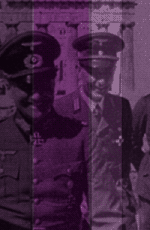

The period of Occupation (1941-44)
The period between June 1941 and the liberation of the country in October 1944 was characterised by two parallel political situations, the interaction of which was bound to play a decisive role for the shaping of the physiognomy and history of postwar Greece.
On the one hand, the official Greek government and King George II, along with selected units of the Greek armed forces, directed the country's foreign affairs from Alexandria, Egypt. On the other hand, from the beginning of summer 1941 the first nuclei of resistance to the German-Italian occupation were formed. This was a phenomenon which was to become of decisive importance in the following years of Occupation.
While the exiled government concentrated its efforts and attention on assisting the Allied forces in North Africa, and on the formulation of formal claims for the country's territorial reconstruction after the war, the resistance groups in the Greek territory tried to subvert the occupying forces by waging a guerilla war, with multiple but limited military operations against German and Italian interests.